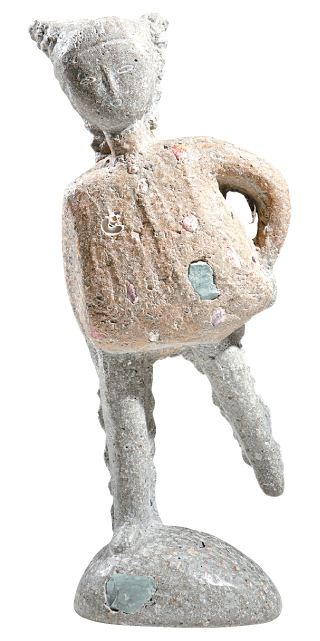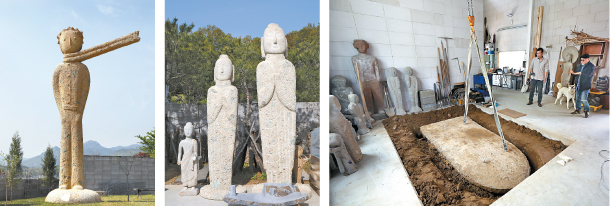[ZOOM KOREA] Sculptor grounds his work in history

Sculptor Lee Yeoung-sup brushes soil off a Buddhist statue he sculpted using Haein Temple’s Maebul, or rock-carved standing Buddha, as a motif. [PARK SANG-MOON]
This is a regular scene at excavation sculptor Lee Yeoung-sup’s workshop located in Yangpyeong, Gyeonggi. As Lee scrapes the soil off the statue’s head, its face begins to appear. It was a statue of a Buddha, with a sharp nose and a lively expression that amazed everyone there.
Lee is a unique sculptor who works using unconventional methods, breaking away from the common ideas and methods of sculpture.

It depends on the statue, but it usually takes at least 10 days for the sculptures to solidify. Lee then scrapes the soil off and washes them with water as the final steps. The final product looks like century-old artifacts that have just been unearthed. At first glance, they look rough and coarse, but the more you look at them, they seem so natural. It is definitely worth the wait.
Lee explains that a childhood memory and the influence of his father are what made him come up with this unique method of sculpting. Lee grew up watching his father, who worked as a carpenter, and his uncle, who baked pottery. When he was young, Lee’s father often told him stories of legends and history. A visit to the Godal Temple in Yeoju, Gyeonggi, later in life was his father’s suggestion. It became a turning point for Lee and changed the course of his career.
Lee’s parents wanted him to be a teacher, so he entered Kangwon National University and majored in arts education. During his university years, he made a name for himself on campus for his skills with terra-cotta, a clay-like earthenware ceramic. His works were so good that professors asked if they could purchase them. He was even able to pay tuition fees for his friends with the money he made by selling his works.
Right after graduation, Lee got a job as a teacher at Samcheok Girls’ Middle School in Gangwon. Yet he submitted his letter of resignation just three weeks into the job so that he could pursue a career as a full-time artist. He then went on to do his mandatory military service and as soon as he got out, he says he only focused on nothing but terra-cotta.

From left: Lee’s Little Prince sculpture which is 6 meters (20 feet) tall; Statues of Unju Temple’s Wabul that Lee created in hopes of globalizing Korean sculpture; Haein Temple’s Maebul is being taken out of the ground by a crane. [PARK SANG-MOON]
Lee stopped working with terra-cotta and headed to where it all began: Godal Temple. He found an abandoned house near the temple and made it his home. There was no electricity, no water. Looking back, Lee says the seven years he spent at Godal Temple were a watershed moment in his life as an artist. For the first two to three years, Lee did not work on anything. He focused only on questions like, ‘What is life?’ and ‘What is sculpture?’
During his time at Godal Temple an excavation project was ongoing nearby. Lee was able to watch the process from beginning to end. He picked up abandoned pieces of roof tiles from the excavation sites and brought them back home. In his front garden, he sketched forms using a chopstick, buried the roof tiles and took them out. He repeated this process and experienced how someone can go from existing to being extinct and then existing once again. That is when he came up with his excavation sculpting method.
Lee completes his work through excavation. His works seem to be imbued with time. His works also show hints of Korean beauty by being simple and blank. As a sculptor, Lee says he is more inspired by the Pensive Bodhisattva statues from the Unified Silla period and the moon jar of the Joseon Dynasty than Rodin’s Le Penseur. He especially loves sculptures that contain Korea’s beauty, he says.
BY PARK SANG-MOON [moonpark@joongang.co.kr]










with the Korea JoongAng Daily
To write comments, please log in to one of the accounts.
Standards Board Policy (0/250자)